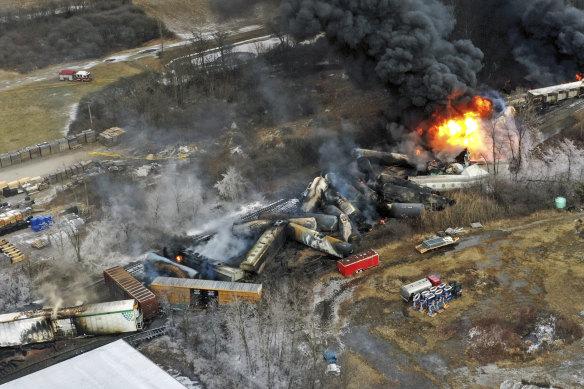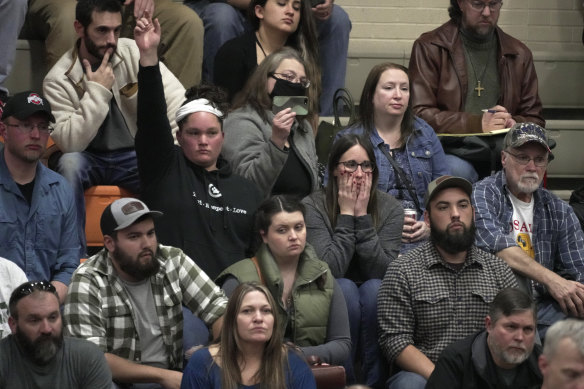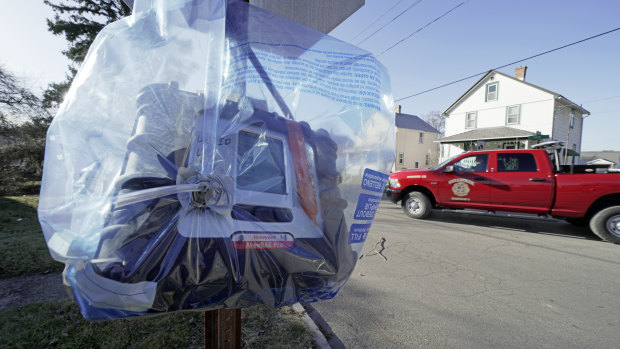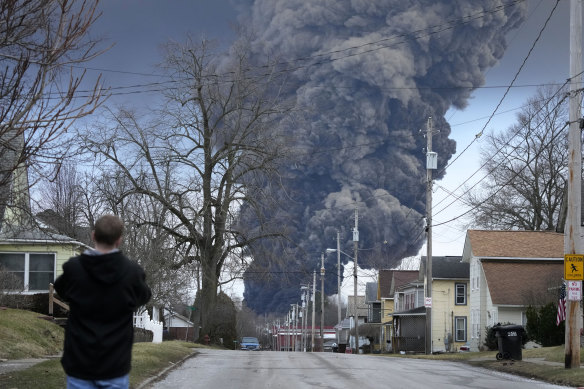Home » World News »
Angry Ohio townspeople seek answers on train’s toxic spill
Lubbock, Texas: Hundreds of irate residents of the Ohio town where a train derailed and spilled toxic chemicals earlier this month packed into a high school gym on Wednesday, seeking answers to what health dangers they still face.
East Palestine Mayor Trent Conaway, looking angry and tired, told the meeting that he wanted to help provide some reassurance for the 4700 citizens of his town, and hold to account those responsible for the train derailment.
“We need our citizens to feel safe in their own homes,” Conaway said as the meeting began. “I need help. I’m not ready for this. But I’m not leaving, I’m not going anywhere.”
taken with a drone shows portions of a Norfolk Southern freight train that derailed Friday night in East Palestine, Ohio are still on fire the day after the derailment.Credit:AP
The toxins-laden train of three locomotives and 150 freight cars was headed from Illinois to Pennsylvania when it derailed. The National Transportation Safety Board (NTSB) said 20 of the cars were carrying hazardous materials, including 10 that derailed.
The NTSB said 38 cars in total left the tracks and the ensuing fire damaged an additional 12.
The train was carrying a mix of items including malt liquor, frozen vegetables and five main hazardous chemicals: ethylene glycol monobutyl ether, ethylhexyl acrylate, isobutylene, butyl acrylate and vinyl chloride. The latter two are used to make soft plastics.
“This tragedy reminds us we have to pay attention not to just what happens to plastic when you are done with it, but the whole life cycle of using massive amounts of toxic chemicals that have to be transported all over the world to make plastic products,” said Judith Enck, a former administrator at the EPA during the Obama administration and now an activist against plastic pollution.
A woman raises her hand with a question during a town hall meeting at East Palestine High School, Ohio, on Wednesday.Credit:AP
The risk of some of those dangerous materials exploding prompted officials to allow the train operator, Norfolk Southern Railroad to run what’s called a “controlled explosion” on February 6, releasing known carcinogens and a black smoke into the air.
Thousands of residents were forced to evacuate. After railroad crews drained and burnt off a toxic chemical from five tanker cars, residents were allowed to return to their homes on February 8.
A air quality monitoring device hangs on a stops sign in East Palestine, Ohio, as the cleanup continues after the derailment of a Norfolk Southern freight train over a week ago.Credit:AP
Much remains unknown of the dangers posed to residents by the toxins that spilled, experts said. Many in the area have complained of headaches and irritated eyes, and noted that chickens, fish and other wildlife have died off. Despite that, state health officials have insisted to residents that East Palestine is a safe place to be.
The NTSB has not commented on the derailment’s cause. A federal investigation into what caused the crash is continuing, as is environmental monitoring inside and outside Ohio.
Railroad union officials have said they have been warning that such an accident could happen because railroad cost-cutting harmed safety measures. But Norfolk Southern said its record has been “trending safer”.
Conaway said the company was working closely with him. “They screwed up our town, they’re going to fix it,” Conway said.
He addressed citizens seated in bleachers, speaking through a bullhorn as he paced around the gym floor.
“They just danced around the questions a lot,” said Danielle Deal, who lives a few kilometres from the derailment site.
A man raises his hand with a question for East Palestine, Ohio Mayor Trent Conaway, centre, during a town hall meeting at East Palestine High School on Wednesday.Credit:AP
Norfolk Southern officials did not attend the meeting, saying they feared violence.
Deal called that reason a “copout” and noted the seriousness of the incident. Deal and her two children left home to stay with her mother, 20km away “and we could still see the mushroom cloud, plain as day”.
A black plume rises over East Palestine, Ohio, as a result of a controlled detonation of a portion of the derailed Norfolk Southern train on February 6.Credit:AP
“After consulting with community leaders, we have become increasingly concerned about the growing physical threat to our employees and members of the community around this event stemming from the increasing likelihood of the participation of outside parties,” the company said in an emailed statement.
Erik Olson, the senior strategic director for health and food at the Natural Resources Defence Council, a non-profit group focused on the environment and public health, said the unknown dangers stemming from the derailment vastly outweighed reassurances that officials have given on safety.
“This is clearly a very toxic brew of chemicals,” Olson said. “And I’ve not seen any public accounting for how many pounds or gallons of any of these chemicals that were released.”
The air and water testing that has been done so far seemed limited and “is not all that reassuring,” Olson said.
He said much more needed to be understood about how the soil and groundwater was polluted from this spill, which he said posed the more significant longer-term danger as opposed to air pollution.
Ohio state officials have said that a plume of pollution in the Ohio River was moving at about 1.6 kilometres per hour. But they say cities in the plume’s path could turn off their drinking water intakes as it floats by. They’ve also said that drinking water tests have not raised concerns and normal water treatment would remove any small amounts of contaminants that may exist.
Gerald Poje, a toxicologist and a former founding member of the Chemical Safety Board, an independent federal agency that investigates industrial chemical accidents, said it could take months or years before the scale of the damage is fully known.
“This is a terrible tragedy in Ohio, it’s so painful to see so many lives put at risk,” Poje said. “There is a long challenge ahead of everybody into how to discern risks that are unknown at this moment in time.”
Poje and Olson said an underground plume of pollution could eventually contaminate drinking water and even irrigation wells that farmers may pump up and spread onto crops.
AP, Bloomberg
Most Viewed in World
From our partners
Source: Read Full Article







